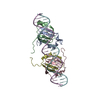[English] 日本語
 Yorodumi
Yorodumi- PDB-2ro4: RDC-refined Solution Structure of the N-terminal DNA Recognition ... -
+ Open data
Open data
- Basic information
Basic information
| Entry | Database: PDB / ID: 2ro4 | ||||||
|---|---|---|---|---|---|---|---|
| Title | RDC-refined Solution Structure of the N-terminal DNA Recognition Domain of the Bacillus subtilis Transition-state Regulator AbrB | ||||||
 Components Components | Transition state regulatory protein abrB | ||||||
 Keywords Keywords |  TRANSCRIPTION / Activator / DNA-binding / TRANSCRIPTION / Activator / DNA-binding /  Repressor / Repressor /  Sporulation / Sporulation /  Transcription regulation Transcription regulation | ||||||
| Function / homology |  Function and homology information Function and homology information regulation of sporulation / sporulation resulting in formation of a cellular spore / negative regulation of DNA-templated transcription / regulation of sporulation / sporulation resulting in formation of a cellular spore / negative regulation of DNA-templated transcription /  DNA binding / identical protein binding DNA binding / identical protein bindingSimilarity search - Function | ||||||
| Biological species |   Bacillus subtilis (bacteria) Bacillus subtilis (bacteria) | ||||||
| Method |  SOLUTION NMR / DGSA-distance geometry simulated annealing SOLUTION NMR / DGSA-distance geometry simulated annealing | ||||||
| Model details | RDC-refined structure of ABrBN | ||||||
 Authors Authors | Sullivan, D.M. / Bobay, B.G. / Kojetin, D.J. / Thompson, R.J. / Rance, M. / Strauch, M.A. / Cavanagh, J. | ||||||
 Citation Citation |  Journal: Structure / Year: 2008 Journal: Structure / Year: 2008Title: Insights into the nature of DNA binding of AbrB-like transcription factors Authors: Sullivan, D.M. / Bobay, B.G. / Kojetin, D.J. / Thompson, R.J. / Rance, M. / Strauch, M.A. / Cavanagh, J. | ||||||
| History |
|
- Structure visualization
Structure visualization
| Structure viewer | Molecule:  Molmil Molmil Jmol/JSmol Jmol/JSmol |
|---|
- Downloads & links
Downloads & links
- Download
Download
| PDBx/mmCIF format |  2ro4.cif.gz 2ro4.cif.gz | 385.6 KB | Display |  PDBx/mmCIF format PDBx/mmCIF format |
|---|---|---|---|---|
| PDB format |  pdb2ro4.ent.gz pdb2ro4.ent.gz | 326.1 KB | Display |  PDB format PDB format |
| PDBx/mmJSON format |  2ro4.json.gz 2ro4.json.gz | Tree view |  PDBx/mmJSON format PDBx/mmJSON format | |
| Others |  Other downloads Other downloads |
-Validation report
| Arichive directory |  https://data.pdbj.org/pub/pdb/validation_reports/ro/2ro4 https://data.pdbj.org/pub/pdb/validation_reports/ro/2ro4 ftp://data.pdbj.org/pub/pdb/validation_reports/ro/2ro4 ftp://data.pdbj.org/pub/pdb/validation_reports/ro/2ro4 | HTTPS FTP |
|---|
-Related structure data
- Links
Links
- Assembly
Assembly
| Deposited unit | 
| |||||||||
|---|---|---|---|---|---|---|---|---|---|---|
| 1 |
| |||||||||
| NMR ensembles |
|
- Components
Components
| #1: Protein | Mass: 6111.287 Da / Num. of mol.: 2 / Fragment: N-terminal DNA Recognition Domain Source method: isolated from a genetically manipulated source Source: (gene. exp.)   Bacillus subtilis (bacteria) / Gene: abrB / Production host: Bacillus subtilis (bacteria) / Gene: abrB / Production host:   Escherichia coli (E. coli) / Strain (production host): BL21(DE3) / References: UniProt: P08874 Escherichia coli (E. coli) / Strain (production host): BL21(DE3) / References: UniProt: P08874 |
|---|
-Experimental details
-Experiment
| Experiment | Method:  SOLUTION NMR / Details: RDC-refined structure of ABrBN SOLUTION NMR / Details: RDC-refined structure of ABrBN | ||||||||||||
|---|---|---|---|---|---|---|---|---|---|---|---|---|---|
| NMR experiment |
| ||||||||||||
| NMR details | Text: Experiments to measure residual dipolar couplings were collected and used to refine the previously released structure of AbrBN |
- Sample preparation
Sample preparation
| Details | Contents: 20mM potassium phosphate, 15mM potassium chloride, 1mM EDTA, 1mM DTT, 0.02% sodium azide, 90% H2O/10% D2O Solvent system: 90% H2O/10% D2O | |||||||||||||||||||||||||||||||||
|---|---|---|---|---|---|---|---|---|---|---|---|---|---|---|---|---|---|---|---|---|---|---|---|---|---|---|---|---|---|---|---|---|---|---|
| Sample |
| |||||||||||||||||||||||||||||||||
| Sample conditions | Ionic strength: 15 / pH: 5.8 / Pressure: ambient / Temperature: 305 K |
-NMR measurement
| NMR spectrometer | Type: Varian INOVA / Manufacturer: Varian / Model : INOVA / Field strength: 500 MHz : INOVA / Field strength: 500 MHz |
|---|
- Processing
Processing
| NMR software |
| ||||||||||||||||||||||||
|---|---|---|---|---|---|---|---|---|---|---|---|---|---|---|---|---|---|---|---|---|---|---|---|---|---|
| Refinement | Method: DGSA-distance geometry simulated annealing / Software ordinal: 1 Details: The structures are based on 3090 NOE-derived distance constraints, 48 hydrogen bonds, 140 dihedral angle restraints, and 48 residual dipolar couplings restraints | ||||||||||||||||||||||||
| NMR representative | Selection criteria: lowest energy | ||||||||||||||||||||||||
| NMR ensemble | Conformer selection criteria: structures with the lowest energy Conformers calculated total number: 10 / Conformers submitted total number: 10 |
 Movie
Movie Controller
Controller















 PDBj
PDBj